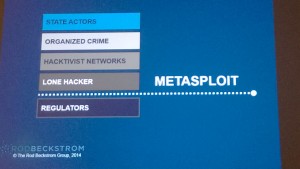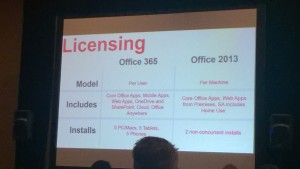ILTA 2014 – Nashville 18th-21st August
Wednesday and Thursday sessions
Planning my Wednesday was always going to be hard, I had a talk to do in the afternoon and the only time to run it through was sometime on the Wednesday itself (especially after I’d decided to take a trip on the Tuesday evening to the Grand Olde Opry to see Carrie Underwood, Terri Clarke, Trace Adkins and others!). So in the end I only managed one session in the morning after the Keynote, the early afternoon was then spent preparing for and then delivering my talk on Mobile Application Management. My talk covered designing, developing, controlling applications on mobile devices. This was based on real world experience of what we’ve done in our firm. If you’re interested in a synopsis in a blog post let me know in the comments.
So the session I did attend on the Wednesday was entitled “Navigating the Decision Tree of Windows 8, Office 2013 and Office 365 (DASPG5)”. This started with a comment in stark contrast to the Windows 8 one on Tuesday;
“If you’re not willing to invest in training then you’re not going to get to windows 8.1, it’s not something a lawyer would just be able to figure out. Also beware of one size fits all training as it’s a generational thing, some who are used to tablets and iPhones they will pick up quickly.”
There were plenty of pieces of advice through the session for those thinking about a move to Windows 8, one I thought particularly interesting was to keep the change to a mininimum. Don’t try and role too many apps at the same time as the new OS. I have to say this was against my current thinking, I’d thought what’s the point in rolling Windows 8 if you’re not going to exploit metro apps (or should that be windows store/windows 8 apps now)? Especially if you’re already on Windows 7, isn’t the reason to go 8 to utilise the new apps for the new form factors (tablets)? But then maybe they were thinking more of a desktop FileSite or Office upgrade at the same time rather than exploiting windows store apps?
Again the “Should I wait for Windows 9?” question came out and again the advice was “No”, this time also pointing out if you go to 9 in the next 18 months you’ll be at the bleeding edge of a new OS with all the challenges that brings. The talk then switched to look at the differences between Office 2013 and Office365. The key differences being:
- The desktop applications for Office 2013 and Office 365 are functionally the same for now. 365 continues to evolve whereas 2013 is a point in time. So for now they’re aligned but 365 will evolve into 2015 etc. 365 updates will come quicker and more often, rather than waiting for service packs etc in 2013.
- The mobile experience for 2013 is much more limited. 2013 is down to your own setup with VDI, remote access etc whereas 365 has all the mobile apps (Office for iPad etc)
- Licencing is a big driver for the choice (see picture below)
- Deployment is also different. Office 2013 is a traditional package and deploy with MSI and office customisation tool. Office 365 is a streaming install from the web or a local share. Both though can be customised.
The session I went to on Thursday morning before packing up to leave for the airport at lunchtime was “Is matter centric all we dreamed of (ECMPG4)”. I have to say I thought it would be a session to challenge our filing methods of MCC, a next generation MCC or MCC 2.0. Maybe new thinking on filing into workspaces, say a new tagging method for DM? But no it really was people still discussing the best folder structures and filing methods for matter centric!
Keynotes from Tuesday and Wednesday
Tuesday’s keynote was by Rod Beckstrom entitled “It’s a mad, mad, mad cyber world”. Now for an Englishman like me, the amount of audience participation involved first thing in a morning (and still on my first cup of coffee!) was a bit much for me, we had to engage in discussion with those around us too for goodness sake! But one thing did happen in this session that you could only get at a legal conference as large as ILTA. After Rod had given an example of a cyber attack on Saudi Aramco during the start of the keynote, where they lost data on 30,000 machines and servers in one day. Who should ask a question during the end questions but the head of legal IT for Saudi Aramco!
Overall the keynote was a fairly interesting run through the need for cyber security in law firms, building on the quote from Joe Patrice editor Above the Law “Law firms are the soft underbelly of American cyber security”. For me the key message that came out loud and clear, both during the talk and on the twitter stream, was the biggest risk was from inside the firm. The picture below was put and this point was made that above all these was the end user.
 (Metasploit is an open source database of cyber exploits, this can be used for both pen-tests or by hackers. The point was that the regulators advice was usually behind this, so planning for what the regulators in legal stipulate is probably not enough. The above items were the levels of threat, so first are the lone hackers, then above them is the hacktivist network e.g. anonymous. Not on this diagram but mentioned was that right at the top was actually the internal users as the weakest link/biggest threat to the firm)
(Metasploit is an open source database of cyber exploits, this can be used for both pen-tests or by hackers. The point was that the regulators advice was usually behind this, so planning for what the regulators in legal stipulate is probably not enough. The above items were the levels of threat, so first are the lone hackers, then above them is the hacktivist network e.g. anonymous. Not on this diagram but mentioned was that right at the top was actually the internal users as the weakest link/biggest threat to the firm)
Wednesday’s keynote was another future gazing talk, this time from Rohit Talwar entitled “Unleashing IT To Disrupt, Define and Differentiate Future Strategies”. It was interesting stuff but the overall gist was what we’ve heard numerous times in legal “Everyone is chasing the premium work, so how do you differentiate?”.
I can see the point and would love to think one prediction he made would could true, that lawyers inside firms are getting frustrated at pace of change or not being able to create new ways of working within their firm. And that these lawyers will break away and work with IT firms and venture capitalists to create new ventures. But I still stand by my posts made here and here on how I think things will pan out.
There were some bits that I did pull out from the keynote that were worth re-airing. That IT should start thinking more like a consultancy, building close business alignment and a strategic approach to management of IT (an example was give of Taylor Wessing who put all their senior IT managers through account management training). Another example given was Seyfarth Shaw:
- They went through and process mapped all matters (currently have about 500 different mapped out as swim lane diagrams)
- Can then play these swim lanes back to the client to talk through exactly how the matter will play out, tailoring these to the client in the chat
- Can then plan these out and come up with a detailed plan and cost for the matter
Finally it wouldn’t be an ILTA without a mention of the vendor hall and this years kicked off with a super hero themed opening on the Monday evening. Most of the big named vendors are in attendance, but I have to say I struggle to get around the hall to see anything new. By the time I’ve seen the sessions, spoken to the vendors we use or are looking at using, there is very little time to see any new stuff (back to the need for a wingman to free up a good session in the hall or a bit more forward planning and arranging of demos in advance!).
Also I think unfortunately a lot of vendors hold their new product press releases until the start of the conference, meaning a) even if I had pre-planned it wouldn’t have been any good and b) by the time the release comes out most of our diaries are over subscribed already. Maybe in future some information or teasers on the new stuff could be released a couple of weeks before the event?
That was my week in Nashville, a very useful and enjoyable conference (albeit very busy). In my last post next week I will focus on one of these new products, one that garnered quite a lot of comment on social media through the week and after. That is Microsoft’s Matter Centre, their DM for Legal based on Office365 in the cloud.




